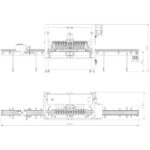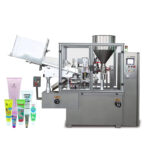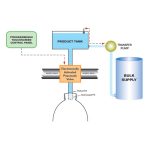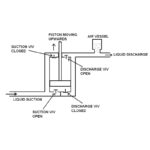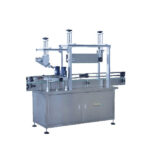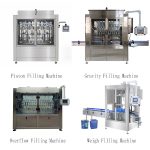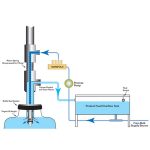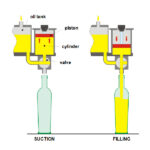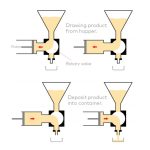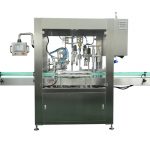A peristaltic pump is a type of positive displacement pump used for pumping a variety of fluids, they are also commonly known as roller pumps. The fluid is contained within a flexible tube fitted inside a circular pump casing (though linear peristaltic pumps have been made). A rotor with a number of "rollers", "shoes", "wipers", or "lobes" attached to the external circumference of the rotor compresses the flexible tube. As the rotor turns, the part of the tube under compression is pinched closed (or "occludes") thus forcing the fluid to be pumped to move through the tube. Additionally, as the tube opens to its natural state after the passing of the cam ("restitution" or "resilience") fluid flow is induced to the pump. This process is called peristalsis and is used in many biological systems such as the gastrointestinal tract. Typically, there will be two or more rollers, or wipers, occluding the tube, trapping between them a body of fluid. The body of fluid is then transported, at ambient pressure, toward the pump outlet. Peristaltic pumps may run continuously, or they may be indexed through partial revolutions to deliver smaller amounts of fluid.[De la Wiki]

Peristaltic pumps are a type of positive displacement pump used for pumping a variety of fluids. The fluid is contained within a flexible hose or tube fitted inside the pump casing. The actual pumping principle, called peristalsis, is based on alternating compression and relaxation of the hose or tube, drawing content in and propelling product away from the pump.

A rotating shoe or roller passes along the length of the hose or tube creating a temporary seal between the suction and discharge sides of the pump. As the pump’s rotor turns this sealing pressure moves along the tube or hose forcing product to move away from the pump and into the discharge line. Where the pressure has been released the hose or tube recovers creating a vacuum, which draws the product into the suction side of the pump, the priming mechanism.
Combining these suction and discharge principles results in a powerful self-priming positive displacement action.
Peristaltic Pump Filling Machine Principle
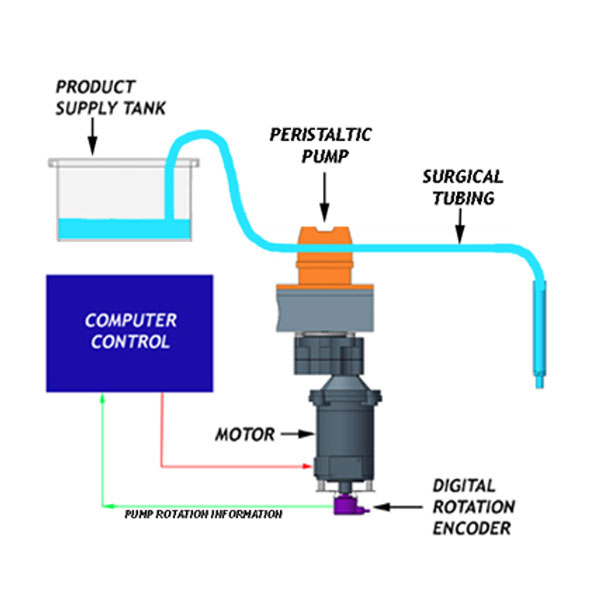
La bomba peristáltica hace contacto intermitente únicamente con la parte exterior del tubo quirúrgico (del producto), de modo que este solo toca la parte interior del tubo. El ordenador principal del sistema de llenado registra de forma independiente las rotaciones del cabezal de la bomba peristáltica (#) para saber con precisión la cantidad de producto dispensado. Cuando se alcanza el volumen de llenado objetivo, la bomba se detiene y el líquido restante no gotea debido a la acción de la pipeta. El ordenador almacena todos los parámetros de llenado en memoria para realizar cambios rápidos.
Solicitud:
Diseñado específicamente para llenados de alto valor y pequeño volumen con una precisión muy elevada. Adecuado para productos acuosos y otros productos de baja viscosidad.
Ejemplos:
Preparaciones farmacéuticas, fragancias, aceites esenciales, reactivos, tintas, colorantes y productos químicos especializados.
Ventajas:
El sistema de fluidos es desechable, lo que facilita la limpieza y elimina los problemas de contaminación cruzada. Se pueden alcanzar precisiones de 0,5% para volúmenes de llenado inferiores a 1 ml.
VKPAK automatic peristaltic pump filling system is an easy to use table-top filling system. It’s suited for small volume fills involving light viscosity products. Its ease of use, quick change over, and no risk for cross contamination make it an ideal filling option for pharmaceutical preparations, perfumes, fragrances, reagents, essential oils, inks, dyes, thin paint, and various other specialty chemicals. This automatic peristaltic pump filling system can be easily be upgraded to as many as 24 channels to meet larger filling needs should they arise. A variety of tubing materials and sizes are available to match your specific product and budgets. Very inexpensive tubing can be used and then discarded, saving costly clean-up time, also, the system pumps most products directly from your bulk tank which eliminates transfer of product from one tank to another.
Filling: Bottle by oscillation tidy up the bottle opener for positioning disk thick, by positioning disk again intermittent drive to filling, stoppering, cover, screw cap. Solution by peristaltic pump suction by silicone pipe, at the filling station again by the needle can be moved up and down automatically filling liquid in the bottle.The needle every move up and down, to complete a filling.
Capping: Add good plug inside the bottle again by positioning disc sent to the affix, screw cap, affix a similar principle and urinating in principle, is done by the cylinder, covering various size by complete, constantly rotating screw LIDS below and overall do up and down, when the bottle stops right, decline of spin trapping modesty lid screw cover finish.Screw cap body adopts the design of constant torque, according to the bottle cap and bottle thread with torsion, to adjust the firmness of the screw cap after puttingin place can automatic sliding, achieve the goal of not wounded cover not bottles.
